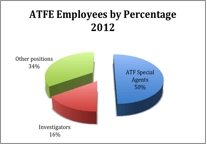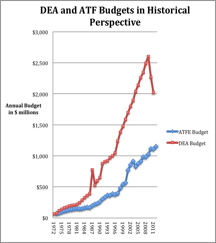
In the third of four blogs on the role of guns in our society, Nathan Jones, the Alfred C. Glassell III Postdoctoral Fellow in Drug Policy, puts the Bureau of Alcohol, Tobacco, Firearms and Explosives’ “Fast and Furious” controversy into perspective.
- Read the Aug. 29, 2012, post, “Corruption: A lethal weapon, too,” by Baker Institute nonresident drug policy fellow Gary Hale, former chief of intelligence for the Houston field division of the Drug Enforcement.
- Read the Aug. 30, 2012, post, “Gun-related violence: A broken link,” by visiting Baker Institute Scholar for Immigration Studies Tony Payan, an associate professor of political science at The University of Texas at El Paso.
The Bureau of Alcohol, Tobacco, Firearms and Explosives (ATF) has been lambasted by the media, Congress and the gun lobby in the wake of the failed Operation Fast and Furious. It is the most criticized law enforcement agency in the United States today and yet has one of the most important, necessary and difficult briefs. It must enforce firearm laws in the United States, a country with an emotionally charged tradition of gun ownership.
Operation Fast and Furious
There are two narratives of the Fast and Furious operation. In the dominant version, guns were allowed to “walk,” as part of an intentional tactic, into the hands of the Sinaloa Cartel in an effort to track guns to high-ranking cartel members. No one disputes that guns bought by straw purchasers, under surveillance in this operation, entered Mexico, or that one was involved in the shooting of Border Patrol Agent Brian Terry. This version has been taken up by congressional Republicans who have demanded the release of all related documents.
Attorney General Eric Holder was held in contempt of Congress following the Obama administration’s use of executive privilege to avoid the release of the documents.
Why the administration exerted executive privilege in this matter is unknown. We can only speculate the possibilities: that confidential emails may have contained controversial political calculations, that the administration believed the issue would fade quietly in the backdrop of an election year, that there was more wrongdoing than previously thought, that sensitive information could not be redacted, etc.
Another version of events has emerged following an in-depth Fortune magazine investigative report that had access to emails and ATF employees involved in the operation. The report paints a very different picture of internal ATF field office squabbles, disgruntled employees and agents “stymied” by prosecutors and loose gun laws.
Without full disclosure from the Justice Department we will likely not know with certainty which version is closer to reality for some time. Holder himself, however, has admitted that “flawed” tactics were used in the operation.
The Wake of Mass Shootings
The mass shootings in Aurora ,Colorado and the Sikh temple in Wisconsin were met with weak calls for gun control reform and loud preemptive rebuttals from gun enthusiasts. Gun enthusiasts often argue that new gun control legislation is unnecessary. Rather they argue existing legislation should be enforced. Unfortunately, the ATF — the federal agency charged with enforcing these laws — is anemic in size and funding, making that mission very difficult.
ATF’s Institutional Weaknesses
The ATF has only 5,025 total employees, of which, only 2,508 are special agents, 624 are investigators and 1,726 are support personnel. Compare that with 128,849 active federal firearms licenses in the United States and it is obvious that the ATF is woefully understaffed to serve its mission. Further consider that many of the records the ATF must sift through are not computerized and we can see the sheer labor hours involved make the task nearly impossible (there are some digitized systems; see ATF website).
ATF vs. DEA: Illustrating Anemic Growth
The ATF and the DEA were agencies with similar briefs in terms of their specialization in particular commodities, their size and scope in the 1970s. Both agencies have similar structures and are composed of roughly half special agents and half support staff or investigators. Thus, a comparison of the two gives a historical perspective on just how anemic the ATF’s growth has been.
Taking historical data on the size and number of employees from both agencies we see that while the ATF has had very little growth, the DEA has expanded dramatically in size and budget
Calls to the ATF confirmed that the above budgetary information is not inflation adjusted, meaning the apparent budgetary growth of the ATF (likely the DEA as well) since 1973 is far smaller than appears in the budgetary chart above.
The charts above beg an important question in the context of the Fast and Furious debacle. What if the type of high-risk/high-reward strategy apparently pursued by the ATF in Fast and Furious was the result of an agency that lacked the resources and manpower to enforce its brief the old-fashioned labor-intensive way? Without a full release of documents, we cannot know and such a release is not likely in the run-up to a presidential election.
While the ATF may be much maligned following the congressional hearings on Fast and Furious, it is the principal federal agency focused on enforcing gun laws. Enforcing existing gun laws is a middle ground where gun control advocates and gun enthusiasts can come together. To achieve the enforcement of existing gun laws, more agents and a better-funded ATF are necessary.
Those who have made a sport of lambasting the ATF should consider what would happen if the ATF were eliminated. The natural agency to take the gun enforcement brief would be the FBI, which would be a much larger and more potent force on gun law enforcement.
 Nathan Jones is the Alfred C. Glassell III Postdoctoral Fellow in Drug Policy at the Baker Institute. His areas of interest include U.S.-Mexico security issues, illicit networks and cross-border flows.
Nathan Jones is the Alfred C. Glassell III Postdoctoral Fellow in Drug Policy at the Baker Institute. His areas of interest include U.S.-Mexico security issues, illicit networks and cross-border flows.



